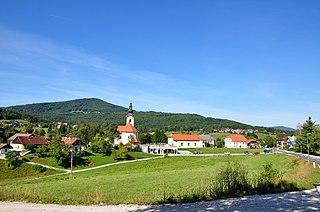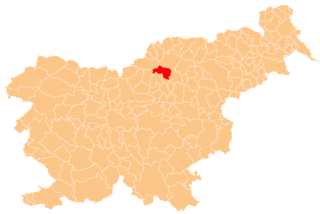
Vuzenica is a town and a municipality in northern Slovenia. It lies on the right bank of the Drava River and extends south into the Pohorje Hills. The area was part of the traditional region of Styria. It is now included in the Carinthia Statistical Region. Vuzenica was first mentioned as a settlement in written documents dating to 1238, but archaeological evidence points to much older settlement of the area with a Roman period burial ground in the town. Of the 13th-century castle above the settlement, only parts of the walls survive.

Kozje is a small town and a municipality in eastern Slovenia. The settlement of Kozje lies in the centre of the municipality, 36 km (22.37 mi) from Celje, 107 km (66.49 mi) from Ljubljana, and 30 km (18.64 mi) from Rogaška Slatina. It is the main settlement of the Kozje region. The area was part of the traditional region of Styria. The municipality is now included in the Savinja Statistical Region. It is one of the oldest settlements in the area, first mentioned in written documents dating to 1016. It was granted market rights before 1384.

Oplotnica is a small town and municipality in eastern Slovenia. It lies on the Oplotniščica River, a left tributary of the Dravinja River, to the north of Slovenske Konjice. The area was part of the traditional region of Styria and formerly part of Austria-Hungary. The municipality is now included in the Drava Statistical Region.

Markovci is a settlement and a small municipality in northeastern Slovenia. It lies southeast of Ptuj next to Lake Ptuj, a reservoir on the Drava River. Traditionally the area was part of the Styria region. The municipality is now included in the Drava Statistical Region.

Šoštanj is a town in northern Slovenia. It is the seat of the Municipality of Šoštanj. The area is part of the traditional region of Styria. The entire municipality is now included in the Savinja Statistical Region.

Makole is a settlement and a municipality in northeastern Slovenia. It lies in the Dravinja Valley. Traditionally the area was part of the Styria region. It belonged to the Municipality of Slovenska Bistrica until 2006, when it became an independent municipality. The municipality is now included in the Drava Statistical Region. It was first mentioned in written documents dating to 1375 and was also granted market rights.

Podgorje is a settlement in the Municipality of Velenje in northern Slovenia. It lies in the foothills of the Ložnica Hills west of the town of Velenje, above the regional road from Velenje to Šoštanj. The area was traditionally part of Styria. The entire municipality is now included in the Savinja Statistical Region.

Prežganje is a settlement in the hills east of Ljubljana in Slovenia. It belongs to the City Municipality of Ljubljana. It was part of the traditional region of Lower Carniola and is now included with the rest of the municipality into the Central Slovenia Statistical Region.

Bele Vode is a settlement in the Municipality of Šoštanj in northern Slovenia. It lies in the Mozirje Hills northwest of the town of Šoštanj. The area is part of the traditional region of Styria. The entire municipality is now included in the Savinja Statistical Region. The settlement includes the hamlets of Kloše, Punčkov Vrh, Visočki Vrh, and Zaloka.

Družmirje is a settlement in the Municipality of Šoštanj in northern Slovenia. It lies just east of Šoštanj with much of its territory flooded after the collapse of abandoned shafts in the Šoštanj lignite mine. The area is part of the traditional region of Styria. The municipality is now included in the Savinja Statistical Region.

Florjan is a settlement in the Municipality of Šoštanj in northern Slovenia. The area was traditionally part of Styria. The municipality is now included in the Savinja Statistical Region.

Lokovica is a settlement in the Municipality of Šoštanj in northern Slovenia. It lies in the hills south of the town of Šoštanj. The area is part of the traditional region of Styria. The municipality is now included in the Savinja Statistical Region.

Ravne is a settlement in the Municipality of Šoštanj in northern Slovenia. It lies in the Mozirje Hills north of the town of Šoštanj. The area is part of the traditional region of Styria. The entire municipality is now included in the Savinja Statistical Region.

Skorno pri Šoštanju is a settlement in the Municipality of Šoštanj in northern Slovenia. The area is part of the traditional region of Styria. The municipality is now included in the Savinja Statistical Region.

Šentvid pri Zavodnju is a dispersed settlement in the Municipality of Šoštanj in northern Slovenia. It lies in the Mozirje Hills northwest of the town of Šoštanj. The area is part of the traditional region of Styria. The entire municipality is now included in the Savinja Statistical Region.

Topolšica is a settlement in the Municipality of Šoštanj in northern Slovenia. The area is part of the traditional region of Styria. The municipality is now included in the Savinja Statistical Region. The Topolšica spa and the Topolšica Hospital are located in the settlement.

Zavodnje is a settlement in the Municipality of Šoštanj in northern Slovenia. The area is part of the traditional region of Styria. The municipality is now included in the Savinja Statistical Region.

Zagradec is a settlement on the left bank of the Krka River in the Municipality of Ivančna Gorica in central Slovenia. The area is part of the historical region of Lower Carniola and the municipality is included in the Central Slovenia Statistical Region.

Kamenica is a small village northeast of Krmelj in the Municipality of Sevnica in central Slovenia. The area is part of the historical region of Lower Carniola. The municipality is now included in the Lower Sava Statistical Region. Until 2001, the settlement included the area of now autonomous settlement of Kamenško.

















